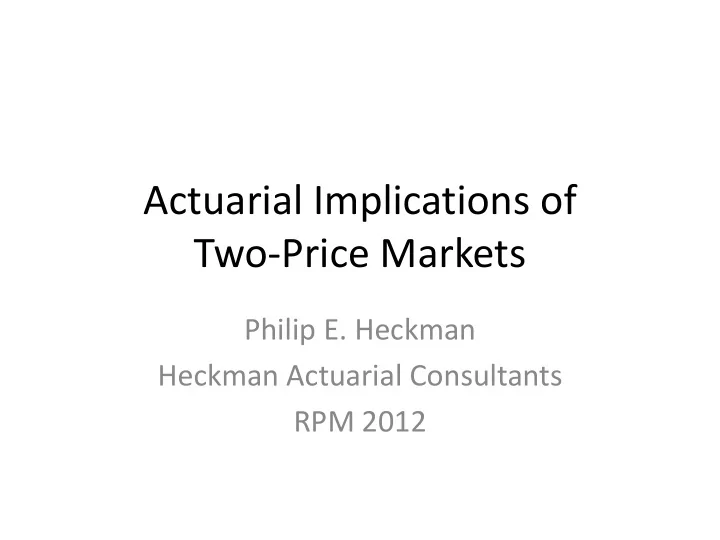

Actuarial Implications of Two-Price Markets Philip E. Heckman Heckman Actuarial Consultants RPM 2012
Review of Findings • Law of one price holds in complete, liquid markets: equities, commodities, and some derivatives. Not in most markets. • In an incomplete market, bid-ask spread measures – Capital needed to support the position, – Cost of unwinding the position, – Amount to minimize in hedging the position, – Cost of surety for the position.
More Findings • Acceptability of a position can be mapped monotone to a probability distortion parameter, e.g . minmaxvar, Wang transform. • When distortion is known, bid and ask prices can be modeled. • Bid and ask are market observables. Proba- bility thresholds for VAR and TVAR are not.
L-N Variable, Wang Distortion, Ask/Bid/Spread vs. Distortion
Calibration • Mapping acceptability to observed bid & ask. • Depends on state of firm and market. • Requires matching model bid/ask to market. • Implies embedding in average market portfolio. • Departures from market average can be hedged.
Actuarial Applications • Valuation of assets and liabilities • Risk margins for pricing and reserving • Assessing capital needs • Allocating capital costs • Optimizing reinsurance terms • Hedging catastrophic losses
Market-Based Valuation • For a forward obligation, transaction price is indefinite – somewhere between bid and ask. • Price swings seen in cycles are structural. • Value assets at bid, liabilities at ask. • Hold differences in actual transactions in reserve, and run off as obligation matures.
Insurance Risk Margins • The modeled ask is a fully risk-loaded price for the obligation. • Unless demand is slack (e.g. bottom of a cycle, visibly impaired credit), insurer can command such a price. • Suggestion: Bid and ask mark the range of the underwriting cycle. • Reserve valuation is governed by a consistent bid sequence. (Hard problem.)
Assessing Capital Needs • Bid-ask spread measures capital needed to support any position in a market context. • Can be evaluated at total portfolio level to estimate needed capital, assess adequacy of surplus. • Places great demands on stochastic modeling. • Level of acceptability must also be decided.
Allocating Capital Costs • Bid-ask spread for a contract measures capital need for embedding in average market portfolio. • Firm’s actual portfolio can be replicated by hedging at no cost. • Needed capital can be charged against the contract at a uniform rate.
Optimizing Reinsurance • Calculate capital cost (bid-ask spread) of holding the net position. • Add the cost of reinsuring to the net position (given) plus cost of default. • Choose the net position that minimizes the sum. • Minimum capital is more robust than other objectives.
Cost of Reinsurance plus Cost of Holding Capital Cost of Holding Capital Plus Reinsurance Hedge Cost of Holding Capital Cost of reinsurance $30 $25 $20 Optimal $15 $10 $5 $0 $1 $4 $7 $10 $13 $16 $19 $22 $25 $28 $31 $34 $37 $40 $43 $46 $49 $52 $55 $58 $61 $64 $67 $70 $73 $76 $79 $82 $85 $88 $91 $94 $97 $100 Value of Attachment Point
Hedging Catastrophic Losses • Detailed account in Section 8 of research paper. • Devise security as stop-loss for industry. • Optimize hedge for single firm under different criteria: 1) Variance, 2) Certainty equivalents under exponential utility, 3) Minimum capital. • Variance too inflexible; CE can lose sensitivity; MC remains robust.
Recommend
More recommend